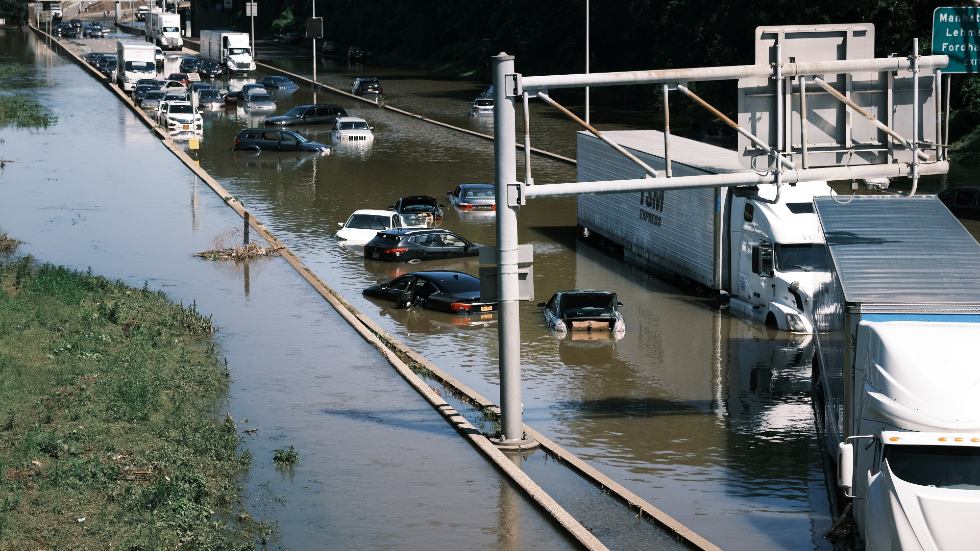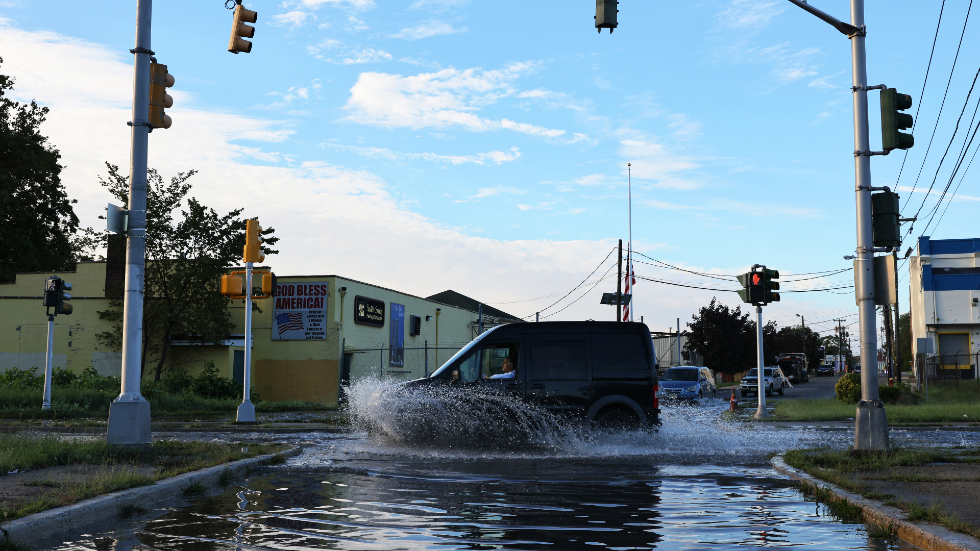Overnight Equilibrium/Sustainability — Presented by Schneider Electric — Subways turn to ‘Niagara Falls’

Today is Thursday. Welcome to Equilibrium, a newsletter that tracks the growing global battle over the future of sustainability. Subscribe here: digital-stage.thehill.com/newsletter-signup.
New York City subway lines were still facing major delays and closures on Thursday after cascades of floodwater gushed over trains as they pulled into stations late Wednesday.
“It turned into Niagara Falls,” a train conductor told the New York Daily News. “People were taking photos when they got off the train. I’ve never seen anything like it.”
The deluges were so dangerous that the city shut down all train service Wednesday evening. As of Thursday afternoon, at least 20 people had died and 150,000 households were left without power in New York, New Jersey and Pennsylvania.
Today we focus more on Hurricane Ida and the deadly rains sweeping the Northeast, leaving unnavigable roadways and flooded train terminals a day after the storm surge. Then we’ll turn to the aftermath of the storm in the South, where locals are struggling to keep cool amid widespread blackouts.
For Equilibrium, we are Saul Elbein and Sharon Udasin. Please send tips or comments to Saul at selbein@digital-stage.thehill.com or Sharon at sudasin@digital-stage.thehill.com. Follow us on Twitter: @saul_elbein and @sharonudasin.
Let’s get to it.
Ida immobilizes New York City, Philadelphia

Dawn brought sunny skies to New York City on Thursday — a deceptively bright greeting after deadly floods drenched the Northeast starting Wednesday evening and throughout the night.
In Central Park, 3.15 inches of rain were recorded in a single hour Wednesday night, breaking a record set the previous week of 1.94 inches of rain during Tropical Storm Henri, The New York Times reported. For the first time, the National Weather Service placed the city under a flash flood emergency.
The storm, according to the Times, transformed the city “into otherworldly and waterlogged chaos” — a scene of “orange traffic cones floating like buoys” and “city buses turned into amphibious vehicles.”
Multiple states of emergency: New York and New Jersey both declared states of emergency.
New York Gov. Kathy Hochul (D) told CNN that the amount of rain was “far more than anyone really expected,” and had left the region in “a very dire situation.”
“We can take all the precautions in advance, and we did deploy our assets to be on the ground in anticipation, but Mother Nature will do whatever she wants, and she is really angry tonight,” she added.
On Staten Island, floodwaters totaled cars and damaged homes, while abandoned vehicles made it difficult for drivers to navigate the roads on Thursday, the Staten Island Advance reported. Most of the West Shore Expressway southbound was closed due to flooding and blocked all the way to the Outerbridge Crossing.
In New Jersey, a devastating tornado ripped through the town of Mullica Hill on Wednesday evening, destroying nine homes and sending debris flying for miles, NBC10 reported.
“I told my wife and kids to get in the basement,” one resident told NBC, explaining that he saw his neighbor’s home being torn apart. “And I looked out the window and I [saw] their house going.”
Philadelphia also suffered from Ida’s wrath, leading city officials to issue a shelter-in-place order to flood-prone areas along the Schuylkill River on Thursday, according to 6ABC. The city’s iconic Boathouse Row was submerged entirely and portions of the Vine Street Expressway were heavily flooded as the river overflowed, The Philadelphia Inquirer reported.
A MESSAGE FROM SCHNEIDER ELECTRIC
19,000+ Schneider Electric U.S. employees make smart energy solutions that are transforming American energy, manufacturing, and infrastructure. Learn more: se.com/us/policy
PORTENT OF THE FUTURE
Where is Ida now? As the storm drifted away from the New York metropolitan area on Thursday morning, the Weather Channel cautioned that Ida’s remnants could “linger” along the Northeast coast but should depart from the East Coast by later in the day on Thursday and make way for a drier weather pattern.
Can cities withstand more extreme storms? That’s a big unknown. New York’s aging transit system, for example, has recently demonstrated repeated vulnerabilities in the face of such challenges. Just 10 days ago, floodwaters submerged city streets and suspended several subway lines when Tropical Storm Henri stopped by the Tri-State area — an ominous prelude to Ida’s arrival.
The massive flooding may in part be attributable to the city’s “combined sewer system.” That means that when even a moderate amount of rain falls, “untreated wastewater is released from hundreds of outfalls into the city’s waterways across all five boroughs,” environmental science and policy researcher Steven Koller tweeted.
Either way, more big storms are coming: Climate change is making hurricanes more powerful and more dangerous, generating larger storm surges near the coast as the storms prepare to make landfall, according to CNN.
“What is so surprising is the time span of the rainfall and the area impacted,” said CNN Weather’s Michael Guy about Ida.
“It is such a large area across the Northeast, and it only happened within a span of a few hours,” he continued. “That’s nothing that we have seen, especially in this region of the country.”
After the storm, the rebuilding

A million people are sweltering without power in Louisiana in the aftermath of Hurricane Ida, as state, federal and local authorities struggle to get the lights back on.
Ida highlights an important point about both disaster preparedness and recovery: Infrastructural failure can lead to a humanitarian crisis all its own.
First steps: The National Weather Service placed New Orleans, Baton Rouge and many other communities hammered by Ida under a heat advisory, predicting temperatures of up to 107 degrees.
“The great challenge is living a life in a sweltering place without air conditioning,” New Orleans resident Karen Evans told The Associated Press.
How bad was the damage? Really bad. Hurricane winds ripped down the lines connecting power plants to substations and substations to houses — creating its own hazards. St. John the Baptist Parish, west of New Orleans, had become a “maze” of downed power lines, Councilwoman Tammy Houston told CNN.
In addition to the downed lines, Ida damaged 5,000 poles and thousands of other pieces of power infrastructure — including the eight principal transmission lines that pipe power into New Orleans, according to Nola.com.
Power restoration is therefore “a delicate balancing act,” meaning that a hasty restoration could knock the whole system back down, CEO Philip May of Louisiana utility Entergy told Nola.com.
In addition to an absence of air conditioning, a lack of power means no sewers or water treatment: 600,000 are without water, according to Reuters.
Limited relief — for the Quarter: On Wednesday evening, lights began to flicker back on in the French Quarter of New Orleans and parts of the larger central business district, Nola.com reported.
But most of the city remained dark — and hot. Heat-exhausted people had driven calls to New Orleans 911 up 185 percent (nearly double the average), Emergency Medical Services director Emily Nichols told CNN.
COOLING VANS, AND LOW FUEL
How do people stay cool without power? With generators, for those who have them — although the operation of these units increased the risk of carbon monoxide poisoning, Nichols said. Such exposure killed one man in St. John the Baptist Parish, CNN reported.
The city has opened seven centers — such as gyms — where people can eat and cool down, and officials will dispatch 70 buses throughout the city as mobile cooling sites, Mayor LaToya Cantrell told the AP.
But all of that depends on fuel, which is running short: In New Orleans and Baton Rouge about two-thirds of gas stations were out of fuel, along with about a third statewide, CNN reported.
In LaPlace, La. — the largest city in St. John the Baptist Parish, halfway between Baton Rouge and New Orleans — a half-mile line stretched four hours back from the sole serviceable gas station, The Wall Street Journal reported.
“If we don’t get power soon, there’s going to be people dying from the heat,” resident Melissa Fritts told the Journal.
What is the government doing? Part of the problem is that key hubs for oil production — like Port Fourchon offshore — are cut off following the storm, Reuters reported.
President Biden announced the federal government would loan oil to Louisiana from the Strategic Petroleum Reserve, a stockpile of crude oil that can be deployed to make up for supply interruptions, The Hill reported.
The administration has also authorized a temporary waiver in restrictions on how many hours gasoline truck drivers can drive, the White House announced on Thursday.
What about electricity? The federal government is sending more than 25,000 linemen from 32 states (and Washington, D.C.) to Louisiana as part of a larger push to help restore power to the region.
But it’s tough going, according to the White House statement. Trees and debris block roads, which have to be cleared by Federal Emergency Management Agency (FEMA), state and National Guard personnel before repairs can begin. Permits have to be issued for new transmission cables across the Mississippi. And then new poles have to be stood up and new lines strung.
And then — once the power is back on and there is fuel for vehicles — the real work can start.
Takeaway: Ida is showing the deadly importance that energy and power infrastructure have to play in any resilience planning. “Electricity is the basic element and foundation of recovery, which is why we’re so focused on making sure that we can make that happen quickly,” White House adviser Cedric Richmond told MSNBC.
It also poses a problem for the renewable energy industry as it faces a world of increasing disruption to the grid: How to create on-demand, dispatchable emergency power that can rival the flexibility of a generator and a jerry-can of gasoline.
A MESSAGE FROM SCHNEIDER ELECTRIC
Learn why Schneider Electric’s products are found in 4 out of 10 U.S. homes, 70% of buildings, 33,000 wastewater facilities, and 50% of hospitals around the world: se.com/us/policy
Thursday Threats

Ida edition.
Many rural towns on the verge of collapse, years after climate events
- The after-effects of climate disasters are stretching many of America’s small towns to the limits, The New York Times reported.
- Even five years after Hurricane Matthew flooded the coastal North Carolina town of Fair Bluff, the community is facing the prospect of insolvency — its only factory closed, the population dwindled and federal home buyouts meant fewer property taxes, according to the Times.
- “If you look at what the folks here called downtown, really the only business that came back was the U.S. Post Office,” Al Leonard, Fair Bluff’s town planner, told the Times.
- As rural communities in extreme weather hotspots struggle to adapt to climate change, the federal government is facing an ongoing dilemma — whether to invest money in building back or help people move elsewhere, the Times reported.
Supply chains reverberate from Ida’s onslaught
- The supply chain crisis will compound — and be compounded by — the complications of rebuilding from Hurricane Ida, The New York Times reported.
- The storm hit supply chains on both the supply and demand sides: it has led to increased competition for the supplies needed to rebuild after Ida, and has also knocked out manufacturing capacity, particularly in the fuel and chemical sectors.
- The supply chain was “already terrible,” but Ida will make it worse, Eric Byer, president of the National Association of Chemical Distributors, told the Times.
Please visit The Hill’s sustainability section online for the web version of this newsletter and more stories. We’ll see you on Friday. {mosads}
Copyright 2023 Nexstar Media Inc. All rights reserved. This material may not be published, broadcast, rewritten, or redistributed. Regular the hill posts








